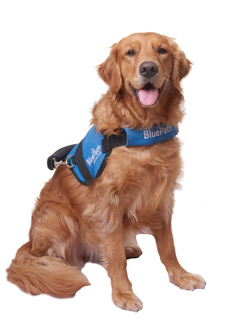Respect the Vest: Working Canines and What They Do
By Arden Hauck

“Kaitlin was a bolter,” said Nancy Flaherty when asked about her 20-year-old daughter, Kaitlin, who has autism. “She was almost killed recently by a car in the parking lot of a supermarket.”
Kaitlin’s life was saved by her service dog, Chester, Flaherty said about the recent incident, and the dog has changed the lives of the entire family in many other ways.
To the public, Chester, a handsome two-and-a-half-year-old black lab, appears as nothing more than an unexpected face in a public setting. However, he is performing a critically important job for Kaitlin, his owner and handler.
Half of the population of children who are diagnosed with autism have a wandering or “bolting” behavior, said Erica Stanzione, director of marketing and development at BluePath Service Dogs, the Hopewell Junction-based organization that trained Chester.
Chester is trained to psychologically and physically anchor his handler in public to keep her safe and prevent her from running away.
“Kaitlin suffers greatly from anxiety,” said Flaherty, a Peekskill resident. “The dog reassures her that it’s okay to go out of the house, even in times where her anxiety is super high.”
Chester also bridges the gap between Kaitlin and the public, allowing her to feel more comfortable socializing with her peers and even strangers. He has taught Kaitlin about responsibility as well, since she is the one who feeds, grooms and walks him.
Moreover, Flaherty swears that Kaitlin’s service dog has completely transformed her family’s dynamic.
“Before we got Chester, we literally were prisoners to autism, and it has given us a sense of normalcy, so that we can, as a family, go out and not have to worry about Kaitlin getting lost or hurt,” she said.
Recently, while in Florida, Kaitlin was accidentally left behind in an elevator. The family panicked, but with Chester by her side, Kaitlin was found in the elevator instead of the incident turning into a traumatic experience.
“The work that BluePath does, not just for autistic children but their families is incredible. They have saved my family,” Flaherty said.
Becoming a Service Dog
The training that goes into a service dog is rigorous and lengthy. Tim Cohen, head trainer at The Guiding Leash Dog Training, said any dog that isn’t taking obedience cues from its owner or is acting out in public can be legally asked to leave the premises by an employee or by law enforcement.
“A service dog should be able to be quiet, calm and relaxed when out in public, whether they are walking from one place to the next or engaged in more static activities such as laying under a table at a restaurant,” Cohen said.
Chester’s training was extensive, beginning with BluePath Service Dogs at eight weeks old.
Puppies are bred through other service dog schools and donated to BluePath. Some come from private breeders. The puppies, mostly labs and golden retrievers, are selected by BluePath, which consistently turns out calm, even-tempered dogs.
At eight weeks, the “purpose-bred” dogs, meaning they possess the superior health and temperament that will allow them to be successful, go to the volunteer puppy raisers. They stay with the raisers until about 18 to 20 months old to learn proper behavior.
Stanzione said after being carefully selected from his litter, Chester spent time in a volunteer puppy raiser’s home learning house manners and potty training as well as experiencing “everything that the world has to offer.”
To practice proper behaviors, the puppy raisers begin to take them out to grocery stores and shopping malls. It isn’t until 18 to 20 months old that the dogs return to BluePath to learn more advanced behaviors and complete their training. The entire process can take up to two years.
Guide dogs, another type of service dog that serve the blind and visually impaired, also do not get matched with their handler until they are about two years old. This includes four to six months of specific task training.
Nancy Teague, founder of Putnam Service Dogs in Brewster, said it is very difficult to successfully produce a service dog.
“It’s an extremely rare dog that can actually do the job, and it’s a long training process,” Teague said.
Putnam Service Dogs’ trainees also partake in two years of rigorous training and come out of it “at an extremely high level of obedience,” Teague said, exceeding the highest level of the American Kennel Club obedience standards.
Mobility Dogs

Putnam Service Dogs is unique in that its dogs come from shelters. This is uncommon, since service dogs are difficult to produce and rescue dogs can have unreliable bloodlines and temperament. Nevertheless, the dogs undergo a careful selection process. Teague explained that in their last class, five of 44 dogs were chosen as appropriate candidates.
Putnam Service Dogs trains dogs for people with mobility issues and physical disabilities. This means performing their most popular task – retrieving dropped or distant objects for their handlers. They also carry items in their mouths for their owners, and in some cases, it can also mean learning to work alongside a wheelchair.
Autism Service Dogs
BluePath trains dogs specifically to keep individuals with autism safe. BluePath matches children with their first dog between three and 11 years old. They train the handler how to use the dog as a tool to keep the child safe in public. The child is tethered to the dog and the dog is taught to anchor the child, using their weight to prevent the youngster from wandering into a dangerous situation. This emotionless response reduces and often eliminates the bolting behavior.
A handle is also used, which the child holds onto as another grounding technique in less stressful situations where a tether isn’t absolutely necessary.
Chester is a “replacement dog” for Kaitlin; she had two previous dogs. Kaitlin had learned not to bolt at a younger age from her first dog.
Guide Dogs
Guiding Eyes for the Blind, an organization in Yorktown Heights that works specifically with individuals who are visually impaired, also divides service dog training into socialization and public access work and professional task training. Guiding Eyes employs a guide harness, teaching the dog the purpose of the equipment to assist the sight-impaired person and direct them.
Becky Davidson, manager of consumer outreach and graduate support at Guiding Eyes, explained that the dog is trained to understand what the harness implies and “what to do when they’re wearing it and the commands that are important for the dog to learn, like forward, left and right.”
Interacting with a Service Dog
How should humans act when they encounter a service dog? The best thing the public can do is let the dogs do their jobs.
“Speak to the person and try to ignore the dog,” Davidson said. “It’s perfectly fine to ask the person about the dog. Whether you’re curious or you’re being friendly, it’s fine to compliment the dog or ask to pet the dog.”
But remember the handler has the right to say no.
“We do not let anyone pet Chester unless Kaitlin gives permission,” Flaherty said. “We put him in a ‘down’ position, so he doesn’t break command, and so he can enjoy someone meeting him.”
Flaherty said she doesn’t mind the requests for information, because “the more we educate the public, the better.”
These animals have important jobs and require appropriate space and respect. Flaherty said. “Chester is like the sentinel by (Kaitlin’s) side,” so their safety relies on the public’s cooperation, she said.
Educating the public includes getting the word out that the law supports service dogs and their work. According to New York State law, interfering with or harassing a service dog in a way that makes it difficult for it to perform its duties is a misdemeanor and punishable by law.
A scary encounter with a person could set a service dog’s training back years or even cause it to be taken out of service work, so it is important to give these dogs the respect and admiration they deserve.
Those interested in learning more about service dogs can visit BluePath Service Dogs at https://www.bluepathservicedogs.org, Guiding Eyes for the Blind at https://www.guidingeyes.org and Putnam Service Dogs at https://www.putnamservicedogs.org.
Arden Hauck is a senior at Horace Greeley High School and is currently owner-training her service dog, Cassie.

Examiner Media – Keeping you informed with professionally-reported local news, features, and sports coverage.
